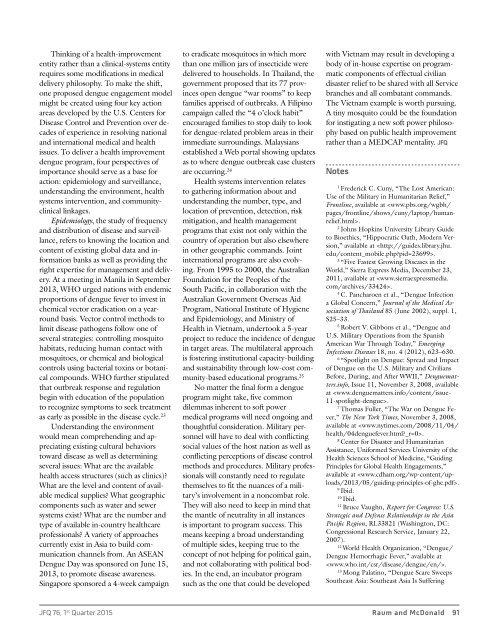jfq-76
jfq-76
jfq-76
Create successful ePaper yourself
Turn your PDF publications into a flip-book with our unique Google optimized e-Paper software.
Thinking of a health-improvement<br />
entity rather than a clinical-systems entity<br />
requires some modifications in medical<br />
delivery philosophy. To make the shift,<br />
one proposed dengue engagement model<br />
might be created using four key action<br />
areas developed by the U.S. Centers for<br />
Disease Control and Prevention over decades<br />
of experience in resolving national<br />
and international medical and health<br />
issues. To deliver a health improvement<br />
dengue program, four perspectives of<br />
importance should serve as a base for<br />
action: epidemiology and surveillance,<br />
understanding the environment, health<br />
systems intervention, and communityclinical<br />
linkages.<br />
Epidemiology, the study of frequency<br />
and distribution of disease and surveillance,<br />
refers to knowing the location and<br />
content of existing global data and information<br />
banks as well as providing the<br />
right expertise for management and delivery.<br />
At a meeting in Manila in September<br />
2013, WHO urged nations with endemic<br />
proportions of dengue fever to invest in<br />
chemical vector eradication on a yearround<br />
basis. Vector control methods to<br />
limit disease pathogens follow one of<br />
several strategies: controlling mosquito<br />
habitats, reducing human contact with<br />
mosquitoes, or chemical and biological<br />
controls using bacterial toxins or botanical<br />
compounds. WHO further stipulated<br />
that outbreak response and regulation<br />
begin with education of the population<br />
to recognize symptoms to seek treatment<br />
as early as possible in the disease cycle. 23<br />
Understanding the environment<br />
would mean comprehending and appreciating<br />
existing cultural behaviors<br />
toward disease as well as determining<br />
several issues: What are the available<br />
health access structures (such as clinics)?<br />
What are the level and content of available<br />
medical supplies? What geographic<br />
components such as water and sewer<br />
systems exist? What are the number and<br />
type of available in-country healthcare<br />
professionals? A variety of approaches<br />
currently exist in Asia to build communication<br />
channels from. An ASEAN<br />
Dengue Day was sponsored on June 15,<br />
2013, to promote disease awareness.<br />
Singapore sponsored a 4-week campaign<br />
to eradicate mosquitoes in which more<br />
than one million jars of insecticide were<br />
delivered to households. In Thailand, the<br />
government proposed that its 77 provinces<br />
open dengue “war rooms” to keep<br />
families apprised of outbreaks. A Filipino<br />
campaign called the “4 o’clock habit”<br />
encouraged families to stop daily to look<br />
for dengue-related problem areas in their<br />
immediate surroundings. Malaysians<br />
established a Web portal showing updates<br />
as to where dengue outbreak case clusters<br />
are occurring. 24<br />
Health systems intervention relates<br />
to gathering information about and<br />
understanding the number, type, and<br />
location of prevention, detection, risk<br />
mitigation, and health management<br />
programs that exist not only within the<br />
country of operation but also elsewhere<br />
in other geographic commands. Joint<br />
international programs are also evolving.<br />
From 1995 to 2000, the Australian<br />
Foundation for the Peoples of the<br />
South Pacific, in collaboration with the<br />
Australian Government Overseas Aid<br />
Program, National Institute of Hygiene<br />
and Epidemiology, and Ministry of<br />
Health in Vietnam, undertook a 5-year<br />
project to reduce the incidence of dengue<br />
in target areas. The multilateral approach<br />
is fostering institutional capacity-building<br />
and sustainability through low-cost community-based<br />
educational programs. 25<br />
No matter the final form a dengue<br />
program might take, five common<br />
dilemmas inherent to soft power<br />
medical programs will need ongoing and<br />
thoughtful consideration. Military personnel<br />
will have to deal with conflicting<br />
social values of the host nation as well as<br />
conflicting perceptions of disease control<br />
methods and procedures. Military professionals<br />
will constantly need to regulate<br />
themselves to fit the nuances of a military’s<br />
involvement in a noncombat role.<br />
They will also need to keep in mind that<br />
the mantle of neutrality in all instances<br />
is important to program success. This<br />
means keeping a broad understanding<br />
of multiple sides, keeping true to the<br />
concept of not helping for political gain,<br />
and not collaborating with political bodies.<br />
In the end, an incubator program<br />
such as the one that could be developed<br />
with Vietnam may result in developing a<br />
body of in-house expertise on programmatic<br />
components of effectual civilian<br />
disaster relief to be shared with all Service<br />
branches and all combatant commands.<br />
The Vietnam example is worth pursuing.<br />
A tiny mosquito could be the foundation<br />
for instigating a new soft power philosophy<br />
based on public health improvement<br />
rather than a MEDCAP mentality. JFQ<br />
Notes<br />
1<br />
Frederick C. Cuny, “The Lost American:<br />
Use of the Military in Humanitarian Relief,”<br />
Frontline, available at .<br />
2<br />
Johns Hopkins University Library Guide<br />
to Bioethics, “Hippocratic Oath, Modern Version,”<br />
available at .<br />
3<br />
“Five Fastest Growing Diseases in the<br />
World,” Sierra Express Media, December 23,<br />
2011, available at .<br />
4<br />
C. Pancharoen et al., “Dengue Infection<br />
a Global Concern,” Journal of the Medical Association<br />
of Thailand 85 (June 2002), suppl. 1,<br />
S25–33.<br />
5<br />
Robert V. Gibbons et al., “Dengue and<br />
U.S. Military Operations from the Spanish<br />
American War Through Today,” Emerging<br />
Infectious Diseases 18, no. 4 (2012), 623–630.<br />
6<br />
“Spotlight on Dengue: Spread and Impact<br />
of Dengue on the U.S. Military and Civilians<br />
Before, During, and After WWII,” Denguematters.info,<br />
Issue 11, November 3, 2008, available<br />
at .<br />
7<br />
Thomas Fuller, “The War on Dengue Fever,”<br />
The New York Times, November 3, 2008,<br />
available at .<br />
8<br />
Center for Disaster and Humanitarian<br />
Assistance, Uniformed Services University of the<br />
Health Sciences School of Medicine, “Guiding<br />
Principles for Global Health Engagements,”<br />
available at .<br />
9<br />
Ibid.<br />
10<br />
Ibid.<br />
11<br />
Bruce Vaughn, Report for Congress: U.S.<br />
Strategic and Defense Relationships in the Asia<br />
Pacific Region, RL33821 (Washington, DC:<br />
Congressional Research Service, January 22,<br />
2007).<br />
12<br />
World Health Organization, “Dengue/<br />
Dengue Hemorrhagic Fever,” available at<br />
.<br />
13<br />
Mong Palatino, “Dengue Scare Sweeps<br />
Southeast Asia: Southeast Asia Is Suffering<br />
JFQ <strong>76</strong>, 1 st Quarter 2015 Raum and McDonald 91




